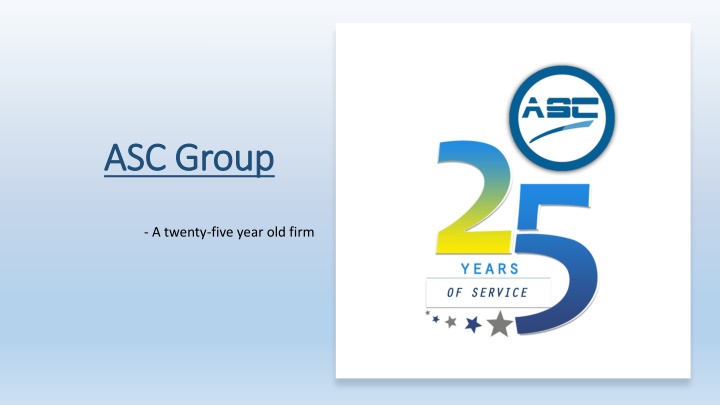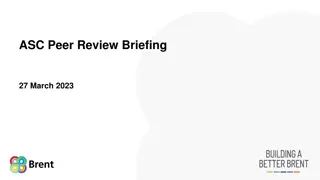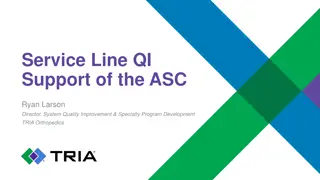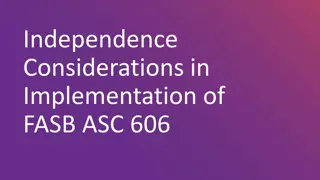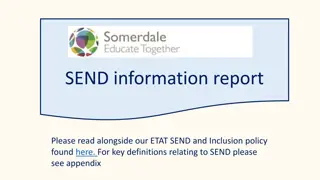ASC Group
In corporate insolvency, the Committee of Creditors plays a crucial role in decision-making and monitoring. Understanding their responsibilities is essential in guiding a successful resolution process. This content explores the key steps and decisions handled by the Committee of Creditors during insolvency and liquidation procedures.
Download Presentation

Please find below an Image/Link to download the presentation.
The content on the website is provided AS IS for your information and personal use only. It may not be sold, licensed, or shared on other websites without obtaining consent from the author.If you encounter any issues during the download, it is possible that the publisher has removed the file from their server.
You are allowed to download the files provided on this website for personal or commercial use, subject to the condition that they are used lawfully. All files are the property of their respective owners.
The content on the website is provided AS IS for your information and personal use only. It may not be sold, licensed, or shared on other websites without obtaining consent from the author.
E N D
Presentation Transcript
ASC Group ASC Group - A twenty-five year old firm
ROLE OF COMMITTEE OF CREDITORS (CoC) During CORPORATE INSOLVENCY RESOLUTION PROCESS & LIQUIDATION Important Steps on which decision are to be taken by CoC or monitoring is required
Whether to do recovery of NPA amount SARFAESI resolution under Insolvency and Bankruptcy Code, (IBC) ? The intent of IBC is to protect enterprise value or economic value of the unit, and resolve a stressed asset which has potential to be revived. Hundreds of employees & suppliers of goods and services are dependent on a corporate debtor under or If this deficiency can be cured banks must resort to IBC to contribute to the national economy. The banks should pickup the resolution process if prepare for it at the very first opportunity when sickness symptoms appear. 2016 Resolutions under IBC entails hiring of professionals to complete important milestone and has higher cost than recovery actions under SARFAESI. The biggest advantage under IBC fixed timeline upto 330 days for resolution of the delinquent asset If banks observe that the stressed assets has no enterprise value, proceeds of assets can be realized in about similar period as IBC they should resort to SARFAESI action as cost are comparatively much less. However, IBC has more teeth and actions under IBC are more effective.
Deciding to go for Resolution under IBC, 2016 Filing & admission of Insolvency application in NCLT under section 7 by NCLT Engagement of interim resolution professional and fixing his fees As through an advocate on the panel of the bank along documentary proof of availing loan amount of default. financial creditor Normally most of the banks have panel of Insolvency professional to chose from, SBI calls for Technical Bid (80% weightage) and Financial Bid (20% weightage), Technical Bid will have parameters like number of resolution plan approved, number of CIRP/Liquidation in hand, number of CIRP/liquidation exposure in the corporate debtor etc. with and Documents will include sanction letter accepted borrowers, disbursement hypothecation/mortgag e deed, proof of ROC charges etc. completed, industry duly the of by proofs, Some banks call for only the Financial Bids assignment to L1. and give Order passed by NCLT, IRP issues announcement for claims. of Insolvency public calling
Filing of Claim with Interim Resolution Professional (IRP) Banks to file claim through electronics means as Financial Creditors (FC) with IRP along with necessary proofs and documents. Claims to be filed within 14 days of public announcement of CIRP. Role of SAM Branch Branch/RO/ZO staff to be vigilant & watchful. Any of the FC can file petition with NCLT. In multiple banking or in consortium One Bank can move NCLT, others may not know. OC can also file petition with NCLT. Branch/RO/ZO staff knows which account is showing warning signals. Public Announcement made by IRP within 3 days of order of NCLT Watch Public Announcement on IBBI website & file your claim with in 14 days. Delayed filing of claim permitted upto 90th day of CIRP, however, cannot change decision of CoC taken earlier.
Meeting of CoC, Quorum, voting share for taking major and minor decisions Notice period of the meeting is 5 days, can be reduced upto 24/48 hours Quorum of the meeting is 33% of voting share Withdrawal of application under section 7,9 & 10 after constitution of CoC with approval of 90% voting share Major decisions by 66% voting share are: Appointment of IRP as RP or replacement of IRP [Section 22(2)], Extension of CIRP beyond 180 days [Section 12(2)], Replacement of RP [Section 27(2)], Approval of Resolution Plan [Section 30(4)], Liquidation Decision by CoC [Section 33(2)] All actions mentioned under section 28 (1) Other Decisions of CoC by 51 % voting share
IBBI Circular dated 10th August, 2019 CoC must be represented by such members who are competent and authorized to take decisions on the spot without deferring decision for want of any internal approval At times it is observed that officials of FC take very long time in conveying there decisions for want of internal approval .They request for extend of e-voting timelines.
Monitoring and Approval of CIRP cost by CoC Role of CoC is to reduce CoC cost and maximize the value of assets of CD, there are two types of cost Fees of professionals/Agencies to be appointed Retainer legal council; Registered Valuers; IT support system for maintaining website, sending bulk mails, conducting e-voting; Security guards; Chartered Accountants for preparing audited balance sheet; Company Secretary for ROC/SEBI compliances; Transaction Record Analyst for avoidance transactions; Insurance of assets of the corporate debtor; Industry Specialist to run the corporate debtor, manager to control the operations of corporate debtor. The cost of running operations of CD (If CD has no revenues or insufficient revenues) CoC toask RP to present monthly performance of operation of CD including flow of fund/revenue, ask RP to reassess/review the number, position and quality of personnel required to keep CD ongoing, permit reduction if employees found excess than requirement looking into scale of operation of CD.
Expression of Interest (EOI) 36(A) CoC to determine/ approve eligibility criteria for prospective resolution applicant(s) R- Generally , three types of PRA s consider e.g. Individuals/ Consortium of Individuals, Companies / Partnership Firms , Mutual Funds/ FII s/ Investors / Equity Funds In case of Real Estate Projects, Resident Welfare Associations also become PRA s Criteria for minimum amount for net worth and minimum number of experiences of the PRA s in the industry of Corporate Debtor are of any other industries as prescribed To take decision on refundable participation fees
Request for Resolution Plan RFRP-36(B) RFRP is standard process document in tune with CIRP Regulations CoC to decide on refundable participation fees CoC is also required to decide on nature, value, duration and source of performance securities, which the successful resolution applicant has to provide after his plan is approved by CoC but before submitting the plan for approval of the NCLT. Such Performance Securities shall be forfeited if the successful PRA s fails to implement the plan partially or fully. Whether any of the Financial Creditors can be PRA s There is no bar under IBC 2019, however, as Chinese Wall for specific inputs not being available to such FC s is to be created
Evaluation Matrix (EM) R-36(B) Pre-determined matrix/criteria on which all to be received Resolution Plan will be examined / weighed Criteria is determined by CoC in consultation with Resolution Professional, communicated to all PRA s in advance Generally, two types of parameters quantitative and qualitative are included in EM Quantitative parameters give marks for upfront(within 30-90 days) contributions, NPV of remaining amounts to be weighed, term of plan etc. Qualitative parameters pertain to financial health, experience of KMP of PRA s, experience in the relevant industries of the Corporate Debtor etc. Comparative weightage of quantitative and qualitative parameters could be fixed by CoC at 70:30 or 80:20
Mandatory Contents of the Resolution Plan R-38:- Provision for payment of CIRP cost The liquidation value or more payable to OC shall be paid in priority to FC Dissenting FC shall be paid in priority to FC who voted for plan, the amount payable be not less than payable under Section 53(1) in the event of liquidation of Corporate Debtor . How it has dealt with interest of all stakeholders Whether PRA s have failed to implement any CoC approved plan earlier Term of plan & its implementation schedule, management and control of business during term of plan & adequate means for supervising its implementation To demonstrate that it addressed cause of default, is feasible and viable, ways for effective implementation, mentions required approvals and timelines, and PRA s capability to implement.
Putting up of compliant Resolution Plan by RP to CoC, examination, presentations by PRA s, Feasibility and Viability of Resolution Plans, submitting CoC approved plan to NCLT and approval of plan by AA:- RP to put up/ submit all compliant plans to CoC along with avoidance transactions details To begin with all PRA s are invited to give their presentation to CoC Normally, PRA s are asked to enhance the amount payable under the Plan and reduce its term, 2-3 rounds of negotiations and improvements in the financial offer is insisted by CoC. CoC to evaluate all plans as per evaluation matrix CoC to record its deliberations on feasibility and viability of each plans CoC to vote on all such plans simultaneously Tie-breaker formula to be fixed in advance if two plans received equal votes, but minimum votes. CoC to approve Resolution Plan by not less than 66% of voting shares of the FC. CoC approved plan to NCLT.
Contact Us Contact Us www.insolvencyservices.in www.ascgroup.in Delhi Office: 73, National Park, Lajpat Nagar IV, New Delhi -110024(INDIA) Tel: +91-11-41729056/7 +91-11-41601289 Registered Office Bengaluru: 4020, Second Floor, 20th Main, 6th Block, Koramangala, Bengaluru- 560095 Noida: C -100, Sector 2, Noida-201301 Tel: +91-120-4729400 Chennai: Level2 78/132 Dr RK salai mylapore Chennai Tamil Nadu 600004 Mumbai: Sagartech Plaza, B-Wing, Office No. 605, Sakinaka, Andheri (East), Mumbai- 400072 Gurgaon: 605 Suncity Business Tower Golf Course Road, Sector 54, Gurgaon, Haryana - 122002 Tel: +91-1124-4245110/116 Branch Office Singapore: One Raffles Place, Tower 1, 27-03, Singapore- 048616 Canada: 885 Progress Ave Toronto Ontario M1H 3G3 Canada International Branch Comprehensive Solutions for Complex Matters
